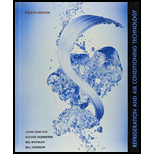
Which is not a pressure or force acting on a TXV diaphragm?
A. Head pressure
B. Evaporator pressure
C. Spring pressure
D. Bulb pressure
The type of pressure or force that does not act on a TXV diaphragm.
Answer to Problem 1RQ
The type of pressure or force that does not act on a TXV diaphragm is Head Pressure.
Explanation of Solution
TXV is a thermostatic expansion valve. It is a component which is used in a refrigeration and air conditioning cycle. It is used for the expansion of refrigerant from the condenser pressure to the evaporator pressure. It controls the amount of refrigerant that which has to be fed from condenser to evaporator. Thermal sensors are installed in this type of expansion device, which maintains a constant superheat in the evaporator.
TXV expansion valve consists of a valve body, a diaphragm, spring, needle and seat, and different types of sensors. The diaphragm which is used in this expansion valve measures the evaporator pressure. The seat in the valve body of a TXV valve is stationary. The needle has an ability to move in the diaphragm. The pressure caused by the bulb acts on the diaphragm and from the other side, its pressure is applied by the evaporator and the spring. The diaphragm moves up and down due to these pressures applied by the different components of TXV. These pressure forces regulate the valve needle at a regular time to open and close.
Therefore, Evaporator pressure, Bulb pressure, and Spring pressure are the active forces which work to move the needle in a TXV diaphragm.
Conclusion:
The pressure or force that does not act on a TXV diaphragm is Head Pressure.
Want to see more full solutions like this?
Chapter 24 Solutions
Refrigeration and Air Conditioning Technology - Package
- Definition of Indicated mean effective pressurearrow_forwardWhich is not a pressure or force acting on a TXV diaphragm?A. Head pressureB. Evaporator pressureC. Spring pressureD. Bulb pressurearrow_forwardA capillary tube system responds to an overcharge of refrigerant by A. high suction pressure. B. high head pressure. C. a flooded compressor. D. all of the abovearrow_forward
- When condenser tubes become fouled, they may be cleaned by A. using a steel brush. B. using a brass brush. C. using a chisel and hammer. D. running a mixture of sand and water through them.arrow_forward________ is a substance that may be used to keep food frozen while a component is being replaced on a freezer.arrow_forwardExplain the principle of operation for thermocouple and resistance temperature detector.arrow_forward
 Refrigeration and Air Conditioning Technology (Mi...Mechanical EngineeringISBN:9781305578296Author:John Tomczyk, Eugene Silberstein, Bill Whitman, Bill JohnsonPublisher:Cengage Learning
Refrigeration and Air Conditioning Technology (Mi...Mechanical EngineeringISBN:9781305578296Author:John Tomczyk, Eugene Silberstein, Bill Whitman, Bill JohnsonPublisher:Cengage Learning Automotive Technology: A Systems Approach (MindTa...Mechanical EngineeringISBN:9781133612315Author:Jack Erjavec, Rob ThompsonPublisher:Cengage Learning
Automotive Technology: A Systems Approach (MindTa...Mechanical EngineeringISBN:9781133612315Author:Jack Erjavec, Rob ThompsonPublisher:Cengage Learning Welding: Principles and Applications (MindTap Cou...Mechanical EngineeringISBN:9781305494695Author:Larry JeffusPublisher:Cengage Learning
Welding: Principles and Applications (MindTap Cou...Mechanical EngineeringISBN:9781305494695Author:Larry JeffusPublisher:Cengage Learning


